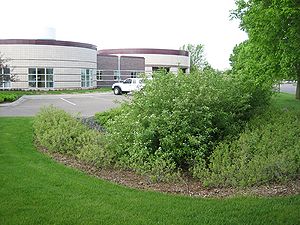
Difference between revisions of "Bioretention"
m |
m |
||
| Line 2: | Line 2: | ||
{{alert|The anticipated construction period for this page is January through March, 2013|alert-under-construction}} | {{alert|The anticipated construction period for this page is January through March, 2013|alert-under-construction}} | ||
| − | Bioretention is a terrestrial-based (up-land as opposed to wetland), water quality and water quantity control process. Bioretention employs a simplistic, site-integrated design that provides opportunity for runoff infiltration, filtration, storage and water uptake by vegetation. | + | [[Glossary#B|Bioretention]] is a terrestrial-based (up-land as opposed to wetland), water quality and water quantity control process. Bioretention employs a simplistic, site-integrated design that provides opportunity for runoff infiltration, filtration, storage and water uptake by vegetation. |
| − | Bioretention areas are suitable stormwater treatment practices for all land uses, as long as the contributing drainage area is appropriate for the size of the facility. Common bioretention opportunities include landscaping islands, cul-de-sacs, parking lot margins, commercial setbacks, open space, rooftop drainage and street-scapes (i.e., between the curb and sidewalk). Bioretention, when designed with an under-drain and liner, is also a good design option for treating potential stormwater hotspots (PSHs). Bioretention is extremely versatile because of its ability to be incorporated into landscaped areas. The versatility of the practice also allows for bioretention areas to be frequently employed as stormwater retrofits. | + | [[Glossary#B|Bioretention]] areas are suitable stormwater treatment practices for all land uses, as long as the contributing drainage area is appropriate for the size of the facility. Common bioretention opportunities include landscaping islands, cul-de-sacs, parking lot margins, commercial setbacks, open space, rooftop drainage and street-scapes (i.e., between the curb and sidewalk). Bioretention, when designed with an under-drain and liner, is also a good design option for treating potential stormwater hotspots (PSHs). Bioretention is extremely versatile because of its ability to be incorporated into landscaped areas. The versatility of the practice also allows for bioretention areas to be frequently employed as stormwater retrofits. |
<div class="center">[[Overview for bioretention]]</div> | <div class="center">[[Overview for bioretention]]</div> | ||
Revision as of 19:51, 12 February 2013
The anticipated construction period for this page is January through March, 2013
Bioretention is a terrestrial-based (up-land as opposed to wetland), water quality and water quantity control process. Bioretention employs a simplistic, site-integrated design that provides opportunity for runoff infiltration, filtration, storage and water uptake by vegetation.
Bioretention areas are suitable stormwater treatment practices for all land uses, as long as the contributing drainage area is appropriate for the size of the facility. Common bioretention opportunities include landscaping islands, cul-de-sacs, parking lot margins, commercial setbacks, open space, rooftop drainage and street-scapes (i.e., between the curb and sidewalk). Bioretention, when designed with an under-drain and liner, is also a good design option for treating potential stormwater hotspots (PSHs). Bioretention is extremely versatile because of its ability to be incorporated into landscaped areas. The versatility of the practice also allows for bioretention areas to be frequently employed as stormwater retrofits.
